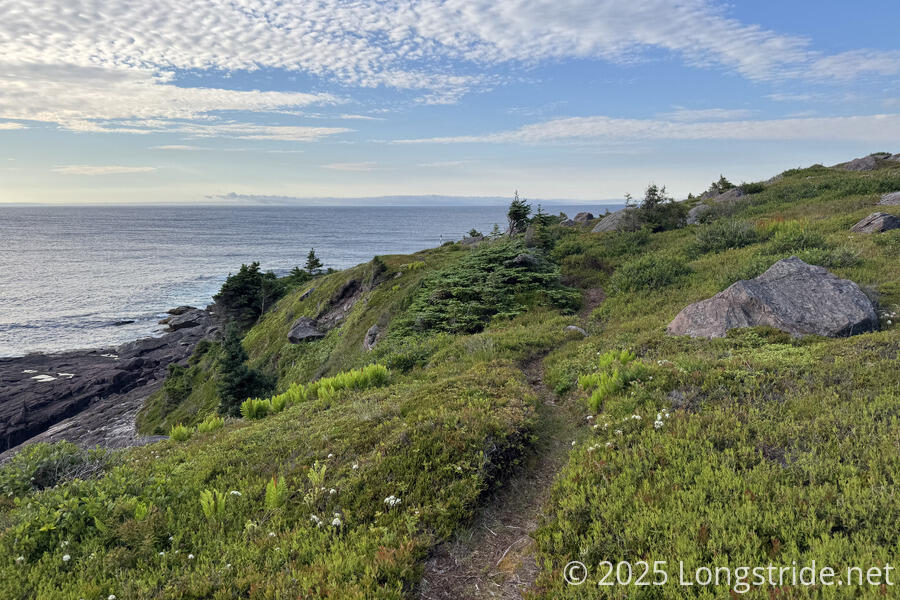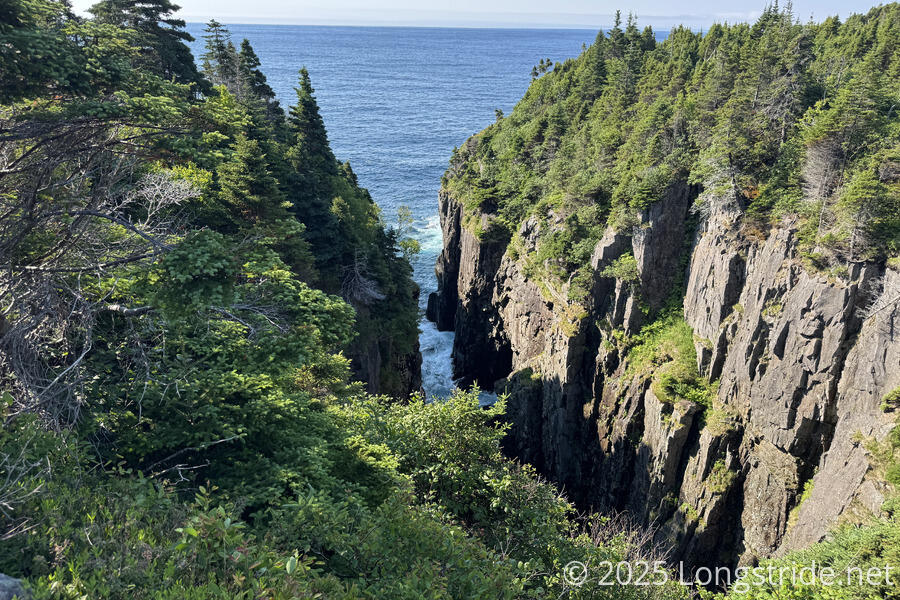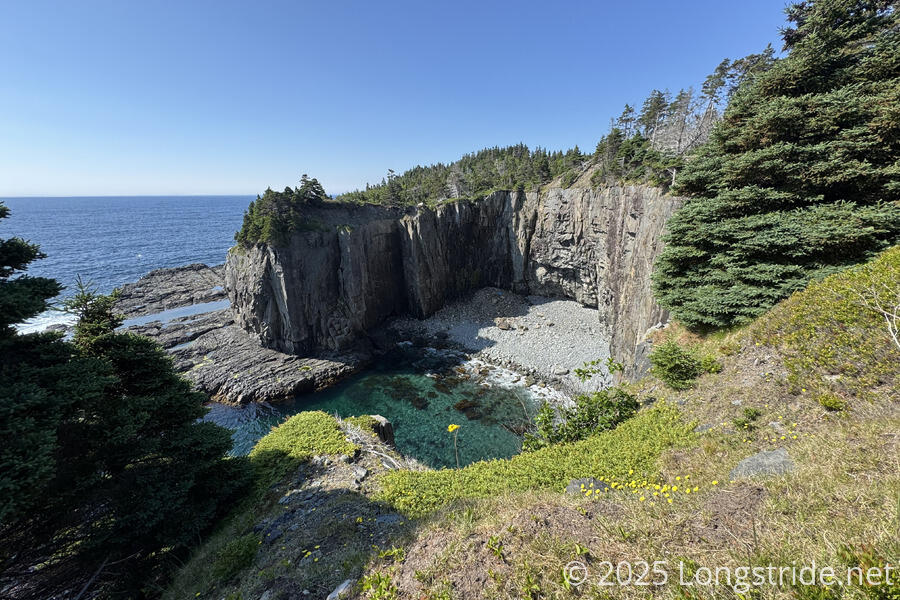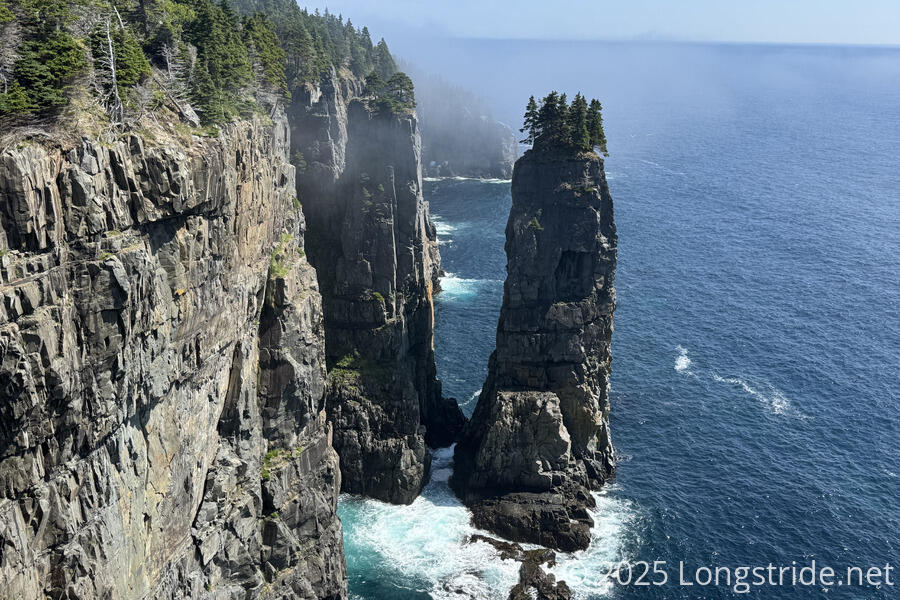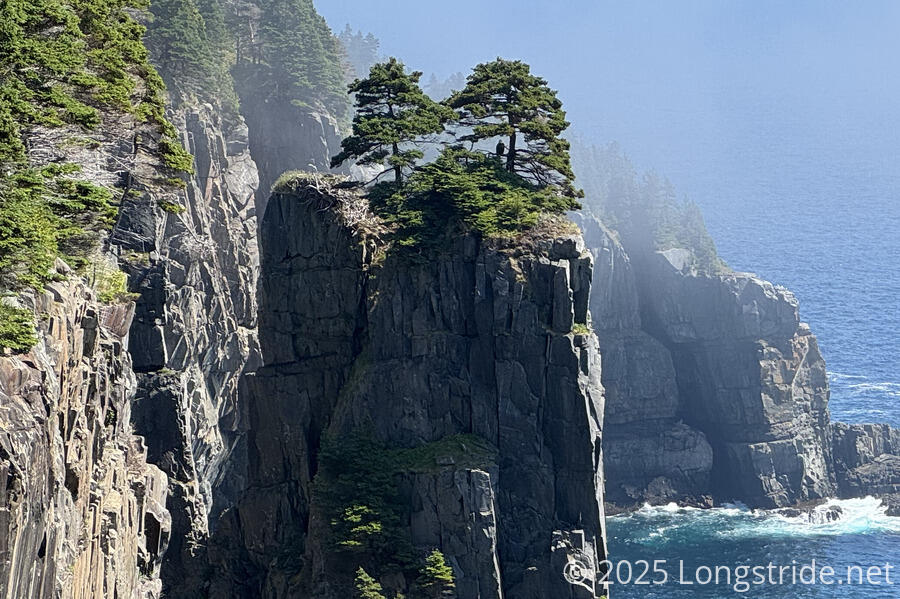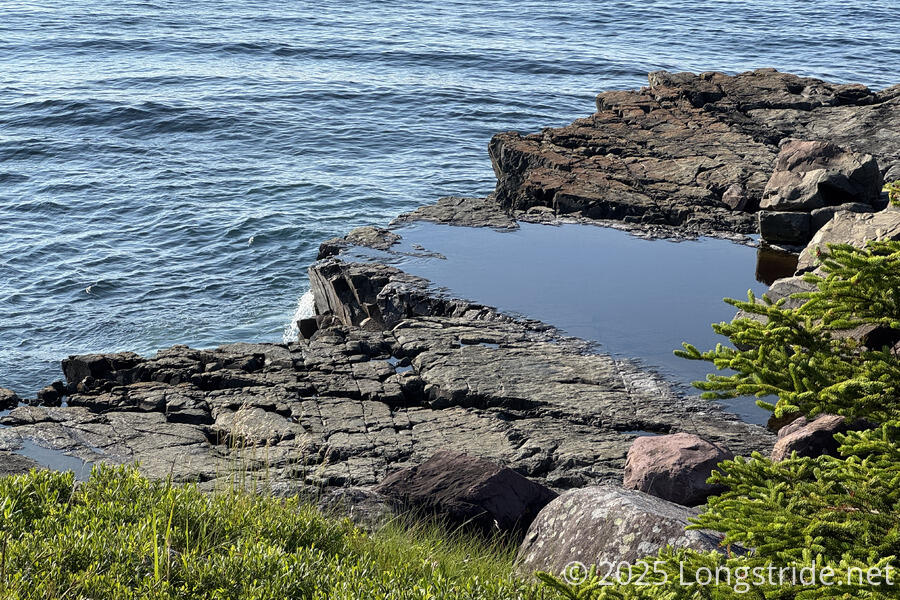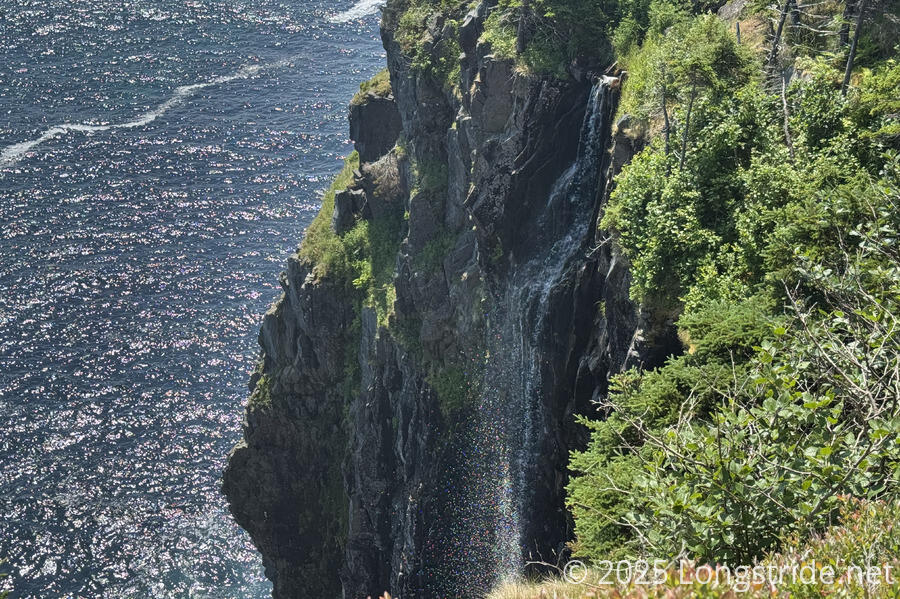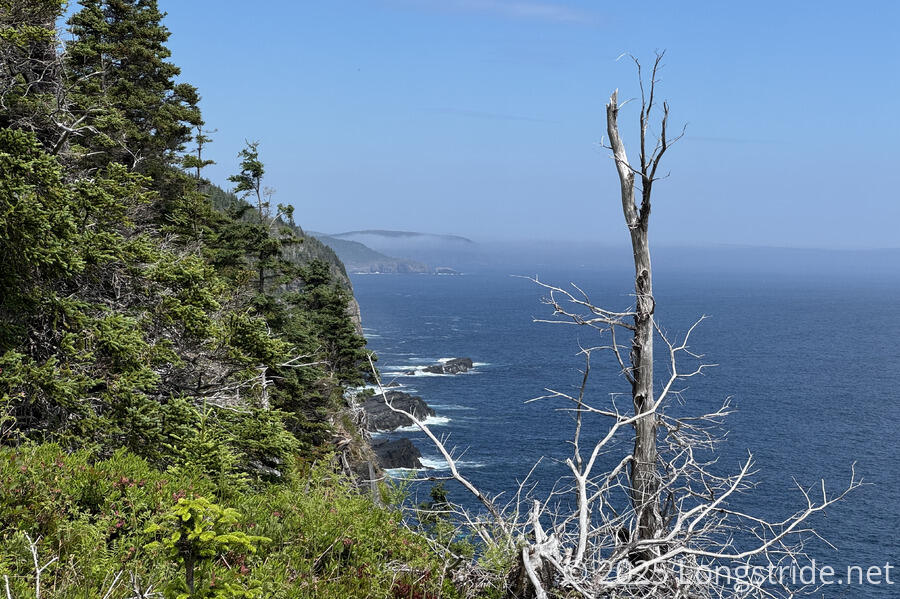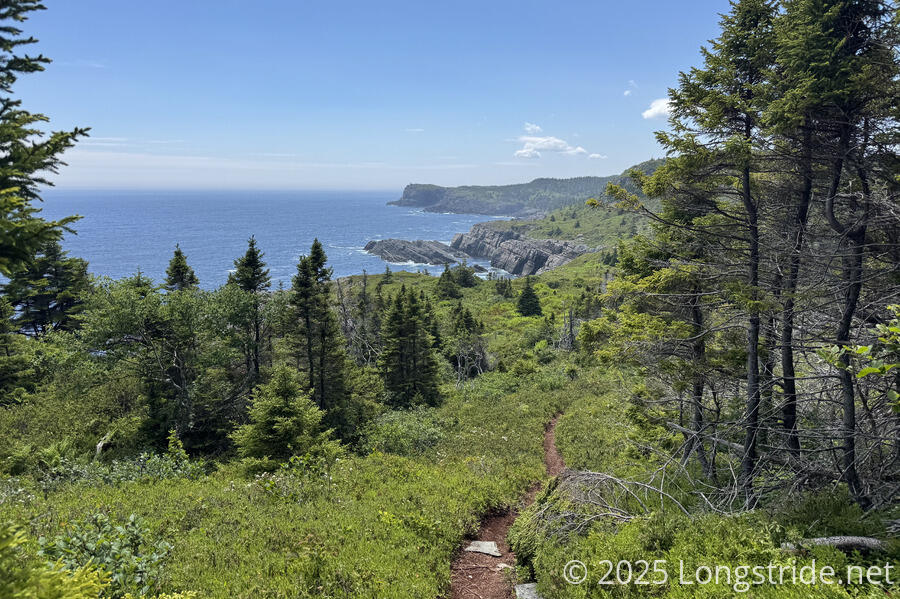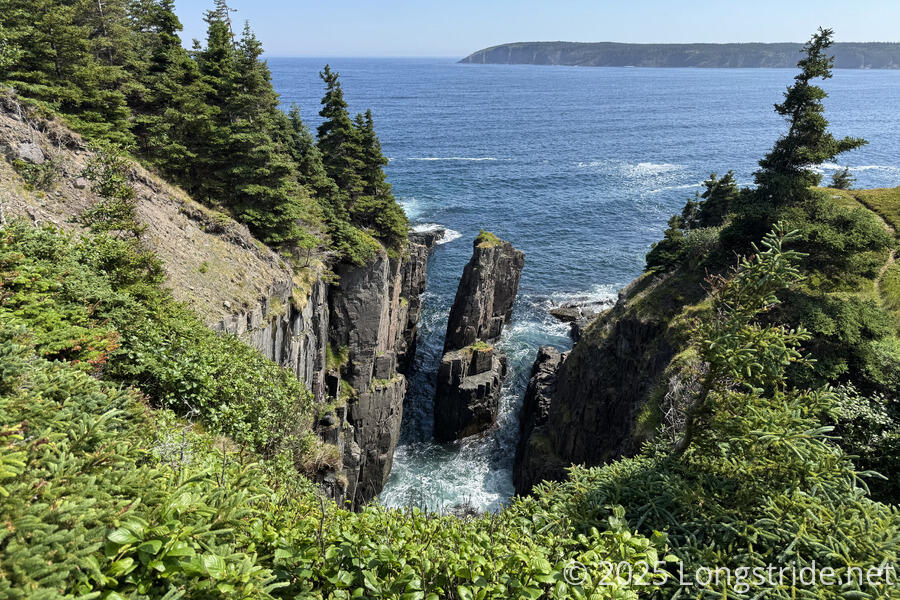A long, difficult day along the Spout Path took us past The Spout, a river-and-wave powered blowhole, to the town of Bay Bulls.
With a 20 km day planned for the remainder of Motion Path and the (also rated difficult) Spout Path, we set an early alarm yesterday and started hiking at 7 this morning.
The day started off beautiful: sunny, with few clouds, and a nice breeze. As we continued south along the Motion Path, it soon became surprisingly warm and humid. And fortunately, the last 2 km of the path were a little easier than the path had been yesterday. Without the fog and wind from yesterday, we could see where we were going, and almost before we knew it, we were at the end of the path.
Along the way, I saw two tiny little fuzzball chicks waddling down the trail, and almost stepped on a third. I’m unsure what kind of bird they were, but their parents didn’t seem to be around.
Motion and Spout Paths are the only two paths on the ECT that directly connect without a community wall in between. There is, though, a long gravel road where the two meet that connects to civilization.
Spout Path started off okay as well, but before long, it became an arduous trek through overgrown pine trees and bush. Though it was only a few kilometers to the next campsite from the path’s start, it felt like it took us forever.
The coast today had very many small, rocky coves, some of which were quite impressive narrow gorges gouged out of the rock. Sometimes unseen, the coast was littered with rocks that make navigation challenging, to say the least. Our map showed over a dozen shipwrecks in the area around the Bull Head Light, which we’d get to later in the day.
The main attraction for the day was The Spout, a regular spout of water produced by the interaction of the Spout River, the waves, and the shape of the rocks. We found it to be interesting, but it wasn’t quite as impressive as I’d hoped it would be. Apparently, the spout is larger in the spring and fall when the river has more water. And presumably a high tide or rough seas might also help. We stuck around long enough for a few pictures, though the rocks near the spout were incredibly slippery, and getting a good picture proved elusive. Also, we were more interested in getting to the Little Bald Head Campsite, about a 15 minute walk further, for a break.
With the heat, humidity, and sun exposure, we took over an hour break at the campsite, which seemed pretty well maintained. I took the opportunity to dry out my soaking-wet clothes (a little wet from the Spout, but mostly from sweat), and we collected and filtered water to camel up and bolster our supply.
Past the campsite, the trail seemed to become significantly better maintained, with far fewer overgrown trees — almost as if maintainers prioritized access from the Spout Path trailhead near Bay Bulls, and not so much the access from the dirt road joining Spout and Motion Paths, and the rest of the day was easier, though still rugged. Tree cover decreased, giving us more sun exposure.
Shortly after leaving the campsite, we passed a giant sea stack that looked a bit like out of a fairy tale, with a small stand of trees on top. Next to it, on an adjacent stack-in-the-making, a bald eagle perched in a tree. We knew they nested in the area, but didn’t actually expect to see one. (Later, we saw a bald eagle fly overhead.)
A little while later, we briefly stopped to chat with a family of three day-hikers hiking towards the spout. About half an hour after that, we passed three more day hikers. From the Bay Bulls trailhead, it’s over a 23 km round-trip. I thought the spout was nice, but I’m not sure it (at least, as it’s spouting today) is 23 km nice. But maybe I’d think differently if I only had a day-pack.
The plentiful rivers along the path today, combined with the coast being a cliff face nearly the entire day, provided ample opportunities for waterfalls into the ocean.
As the afternoon progressed, it continued to be hot and humid out, with plenty of sun. Fog formed out to sea, especially towards the north. Looking back towards Motion Bay, we could see that the fog was flowing into the bay, giving whomever is hiking there today the same poor visibility we had yesterday.
I also passed a milestone: 18,000 km on long-distance hikes!
As we progressed southwards, eventually we were able to see the Bull Head Light, standing near the entrance to Bay Bulls.
Shortly before reaching the light, we passed a couple heading north, hiking from Ferryland to St. John’s.
The Bull Head Light was a small affair, just a basic tower with a light. About fifteen minutes later, we found a large grassy area overlooking Bay Bulls (the bay), and stopped for a long break, while we figured out where to stay next. Options in Bay Bulls (the town) seemed limited, but we wound up in contact with a place with the eminently catchy name “Best View Efficiency Units”. They had a minimum two night stay. We didn’t really want to zero, so we said we’d consider it and let them know. A minute later, they called back, offering to shuttle us to/from the trailhead tomorrow and the day after so that we wouldn’t have to hike tomorrow with full packs. This piqued our interest, especially since the weather forecast for tomorrow wasn’t looking the greatest: we could hike, and still start with dry clothes the day after. We accepted the offer.
The rest of the hike to town was much easier than it had been earlier today, though the dramatic views still continued. We saw six more hikers on our way to town, including a couple hiking from Cappahayden to St. John’s.
The air got a bit hazy, and we noticed that steam was rising from some rocks as the waves came in. Probably the tide was coming in now, and the dark rocks were very hot after baking in the sun all day.
We reached the end of the Spout Path, joining a gravel road that took us towards town. A few minutes before we arrived at our lodging, Don, the owner of the place, drove past us on the road, offering us a ride to the unit, or alternatively, the food store or restaurant in town. (We declined — we wanted to keep our continuous footpath from the start of the trail.)
After we got settled (and showers), we walked to the Foodland, about a kilometer down the road, to get food for dinner, breakfast tomorrow, and for tomorrow’s hike. (We’ll do our resupply for the next stretch tomorrow evening, after we actually plan it out.) At the food store, we ran into a former long-distance hiker, who’d done the major US trails I did, though not in the same years. We also ran into the husband of the family we’d met near the Spout, who was excited to show us video of a family of eagles at the sea stack we pointed out (we only saw one eagle), and two whales swimming near the stacks! (We were a little jealous; timing is everything, and they got more lucky than we did.)
A light rain started after we finished dinner, dampening some of our clothes we’d set out to dry.
Tomorrow, we plan to get up early to hike 24 km, which will cover the next two sections of trail and three community walks, bringing us to a trailhead we’ll start at the day after tomorrow. Tomorrow’s trails are supposed to be easy, but now, we know they’ll definitely be wet.
